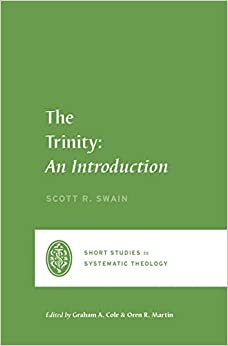Swain, Scott. The Trinity: An Introduction (Short Studies in Systematic Theology). Wheaton, IL: Crossway, 2020, pp. 154, $15.99, paperback.
Scott R. Swain serves as president and James Woodrow Hassell Professor of Systematic Theology at Reformed Theological Seminary in Orlando, Florida. In addition to the book being reviewed, he has written The God of the Gospel and edited Retrieving Eternal Generation. Swain is an ordained minister in the Presbyterian Church in America.
In The Trinity: An Introduction, Swain seeks to introduce the doctrine of the Trinity. As part of Crossway’s series Short Studies in Systematic Theology, the goal of the present volume is to give readers a brief but accurate overview and introduction into the area of the Trinity. While it is a challenging assignment, Swain handles the doctrine of the Trinity with precision.
While not explicitly divided into sections, The Trinity: An Introduction functionally has three areas. In chapters 1-3, Swain helps readers gain their footing in thinking about issues of the Trinity. Chapters 1 and 2 cover fundamental matters of grammar and text types that discuss the Trinity. Swain focuses on the need to understand God as one existing in three persons, and these first two chapters focus on that unity of personhood. While focusing on the unity of the personhood of the Trinity, terms are carefully defined, and readers are pointed to specific Biblical texts that show the basic structure and contours of Trinitarian thinking. Chapter three is a helpful description and brief analysis of the doctrine of Divine Simplicity concerning the Godhead. Simplicity is a difficult doctrine to comprehend, but Swain does an excellent job of helping readers grasp simplicity.
Chapters 4-6 could be described as section two, where Swain addresses issues related to each person of the Trinity. He carefully walks through issues related to all three persons of the Godhead while saturating each person’s work with Scripture. Chapter four focuses on God the Father. By concentrating on grammar issues dealing with God the Father, it is possible to see the unique role that the Father plays in the personhood of the Trinity while not confusing the unity and other roles that the Son and Spirit operate. Readers will find Swain’s work in chapter five on the Son particularly helpful. Noting the recent discussion and debate on Eternal Functional Subordinationism (EFS), Swain concisely explains the error as he sees it with EFS. While proponents of EFS will disagree with the presented argument, Swain’s description of EFS is fair and charitable. The final chapter in this section covers the Spirit’s work and the office that the Spirit occupies. Swain is careful to show readers how the Spirit operates while avoiding the issues in holding to EFS.
The final section of the book takes the reader back to the issue of the Godhead once more as chapters 7 and 8 covers the subject of God’s work. In chapter seven, Swain reminds readers, “the works of God are not a matter of three friends getting together, each getting together, each doing his part, to accomplish a common goal. Nor are the works of God the exhibition of an indistinct force. The worlds of God are the works of the thrice-holy Trinity” (p. 108). Chapter 7 also returns to the issue of EFS one more time as the missions of God are explained and how those missions should not be seen as subordinationism. Instead, divine missions exhibit both the inseparable nature of God’s external works and the Trinitarian shape of God’s external works (p. 119). The final chapter of the work focuses on the end of God’s work. Swain attempts to pull all of the material together and show how the Trinity helps the church and pastor’s as they seek to minister. Swain quickly reminds readers that God’s supreme end in His works is a supreme act of charity because nothing enriches God and nothing adds to His glory (p. 127). Readers are helped as they see that the triune God is on full display through preaching and the sacraments provided that He is exalted.
Swain’s work on the Trinity is a valuable gift to students and the church alike. The aim of the series and Swain’s ability readers seeking to dive deeper into the study of the Trinity will be well served. Not only is the work helpful for students, but lay leaders and church members will also find The Trinity: An Introduction an accessible entry point into studying the Trinity. As pastors and theologians need refresher material on Trinitarian issues, Swain’s work should be recommended not only for its brevity but for its accessibility.
Swain is also helpful for those looking for concise, careful, and useful rebuttals to the issue of EFS. With only a few pages dedicated in multiple places in the book, readers can find helpful answers to the debate surrounding the Trinity without feeling overwhelmed.
Readers will need to be aware that just because the volume is short does not mean a lack of technical terminology and work. While not surprising given the nature of the Trinity, but readers will need to be aware nonetheless. Also, while the series is intended to be brief, readers may feel like they are not getting the complete discussion on all topics discussed. It is important to remember that the aim of the volume and the series is to be brief but accurate. Swain helps the reader who wants to dive deeper as his footnotes are helpful extensions of the book’s arguments and provide descriptions of useful volumes that will carry the reader deeper into a discussion on the Trinity.
Finally, Swain is to be commended for his work in saturating the book with Scripture. He does an excellent job of walking the reader through brief portions of Scripture on the Trinity and pointing to texts to support his argument further. The textual nature of the book will serve the reader well as they study the Trinity.
David Botts
Midwestern Baptist Theological Seminary





